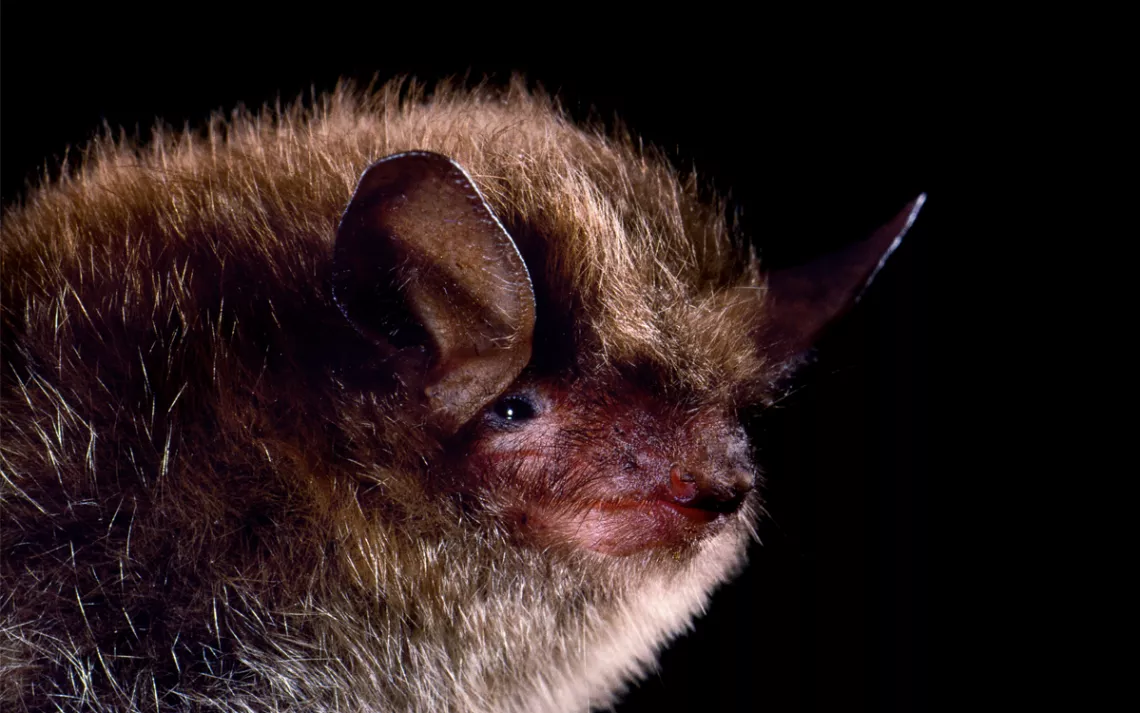In Search of Alaska's Tiny Bat Introverts
These little brown bats are small, dark, fast, and silent—at least to our ears

A little brown bat. | Photo by Merlin Tuttle/MerlinTuttle.org
Thirty miles from downtown Juneau, Alaska, the team pulled over at what seemed like a random stretch of Sitka spruce and hemlock rainforest. Three women hopped out and set off, straight uphill. The route passed for a trail only because graduate student Tory Rhoads and technician Honalee Elkan had hiked the path all summer. This was the way to bat country.
Not that we expected to see one. In all the time I've been hiking here, I've never encountered a bat, though six species live in the area. Miners and cavers don't see them either. Little brown bats, Myotis lucifugus, are small, dark, fast, nocturnal, and silent, at least to our ears. What is known about them is largely thanks to Julia Boland and Doreen Parker McNeill, two scientists who started a bat-research program in Juneau in the 1990s, and to biologist Karen Blejwas and her small team at the Alaska Department of Fish and Game. "Generally, out West, nobody knew where their little brown bats were hibernating," Blejwas said. "This is the bat frontier!"
Karen Blejwas's dog, Ziggy. | Photo by Kate Golden
The usual spooky mist wove through devil's club leaves and loaded-down huckleberry bushes. The ground was more moss and needles than solid earth. The hillside was a wobbly soufflé. A non-bat-informed hiker would be hard-pressed to distinguish this patch of tall, dark Southeast Alaska from any other. But some places are batty, and some are not.
"This is kind of the upper limit of the good habitat," Rhoads told Blejwas, as they stopped. Beyond this point was "kinda shwacky," anyway—"treacherous and miserable."
Now is the time for environmental journalism.
Sign up for your Sierra magazine subscription.

Rhoads has a scale for determining a site's bat potential. This one? "Thirteen out of 10!" Why? Rhoads waved toward a sheer rock wall flanked by tiers of lesser walls—a hill like an amphitheater. Bats follow features like these. The forest was relatively clear of undergrowth, providing a flyway. All down the hill was a tumbled-down mess of boulders, what Rhoads described as a "mossy staircase." The money spots, batwise, were black holes nestled in the boulders, some with cool air at the entrance that indicated a microclimate within.
Blejwas nodded approval. This place looked just like another field site that had proven especially batty.
Rhoads said, "If there aren't bats here, I quit."
In 2006, a fungus arrived in New York State and began wiping out bats, one cave at a time. The disease it caused, white-nose syndrome, was named for the powdery muzzles of infected bats, which wake up during hibernation and die of starvation. It's hard to overstate how little Alaska knew about its bat population at the time. Blejwas, hired in 2005, was part of an effort to change that. Back then, she wondered if the bats might merely migrate through Juneau and hibernate who-knows-where. Her team began hiking after dusk with a bat recorder, which translates high-pitched bat squeaks into sounds humans can hear. The night walks brought the rainforest alive in an entirely new way. "We found bats on every single trail," she said.
Blejwas, Honalee Elkan, and Tory Rhoads (from left) pause at a slope of mossy rubble to discuss how best to spy on the bats living in the network of crevices beneath it. | Photo by Kate Golden
The next step was to catch them in mist nets and tag them. Since GPS collars aren't an option for an animal that weighs six grams, Blejwas glued 0.3-gram radio tags on dozens of bats, then hired a pilot with a Piper Cub outfitted with special antennae to fly her around Juneau after sunset to track them.
That was how Blejwas found her first bat hibernaculum, three years after she began looking. It was less than a kilometer from the original mist-netting spot.
Juneau has plenty of caves, but the bats were hibernating in holes instead—either alone or in small groups. "People really thought we hadn't searched enough caves yet," Blejwas said. "Science is biased toward caves because there are lots of bats to count there."
So far, most Juneau hibernacula have turned up in networks of interstitial crevices under rubble, like the mossy staircase. These semi-insulated spaces, known as the Milieu Souterrain Superficiel (thanks to the European entomologists who coined the term), mute the coldest winter temperature spikes—particularly in snowy winters. Blejwas and her team have become connoisseurs of holes in the ground.
"I probably have more pictures of holes in the ground than I do of people," Blejwas said.
That obsessive noticing bleeds into other pursuits. As they scampered up and down the mossy staircase, strapping cameras and audio recorders to trees and discussing the battiness of various holes, Elkan and Rhoads stopped to pick chanterelles, boletes, and angel wings. I recognized the involuntary obsession of hunter-forager mode (I once sprained my ankle because I couldn't stop hunting chanterelles while jogging). All mental resources are directed toward sussing out patterns in a complex landscape: why the mushroom—or the bat—lives here and not there. The researchers live in this mode. Rhoads said she doesn't even like mushrooms all that much.
For years, Blejwas's dog, Ziggy, a fetch-obsessed border collie–spaniel mix, accompanied her during fieldwork. Blejwas would pause at each field site and throw her a stick. When Ziggy later began getting excited as they approached a stop, Blejwas realized that she had memorized the locations and wondered if dogs could be trained to help find bats.
Today, Rhoads was testing that hypothesis by setting up cameras at spots identified by two dogs trained by Rogue Detection Teams to detect bat scent. So far, Blejwas and team have found 16 hibernacula, six of them with dogs.
Eastern bats may swarm by the thousands at cave entrances, but the largest swarm caught on video around Juneau was just seven bats. The little brown bats' preference for socially distant housing may protect them from the worst ravages of white-nose syndrome. Back east, the fungus whips through caves, superspreading like a coronavirus in a concert hall, but it's slower to jump between caves. White-nose arrived in Washington State in 2016 but has yet to appear in Alaska.
A federal review is underway as to whether little brown bats should be listed as endangered across North America. Blejwas thinks that bats in the West are going to have bigger problems than white-nose. Wildfires threaten great swaths of bat country, and Southeast Alaska's weather is getting warmer and weirder. Blejwas doesn't know what it all means for the bats yet. But at least now she knows how to find them.
This article appeared in the Spring 2022 quarterly edition with the headline "Hide and Seek."
How to Meet Your Local Bats
Bats live throughout North America, and they aren't all as hard to find as those in Southeast Alaska. Here are some ways to connect with them.
Go on a bat walk
Local conservation groups organize sunset walks to introduce people to their local species. Use an app like iNaturalist for tips on where bats are in your area and go lurking around dusk.
Make your backyard bat-friendly
The nonprofit Bat Conservation International offers some tips: Consider leaving dead trees standing for bats to roost in. Keep your cats inside. Avoid using pesticides.
Build a bat house
In many places, bats can use a little extra habitat. Bat houses are designed to mimic the comfy space between a tree's trunk and bark and are simple to build. If bats move in, they'll eat your backyard mosquitoes and fertilize your garden. Bat Conservation International has free plans online.
 The Magazine of The Sierra Club
The Magazine of The Sierra Club



